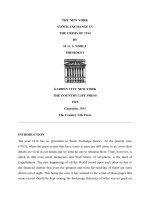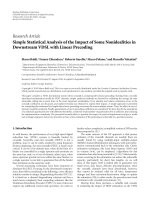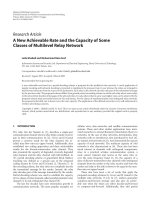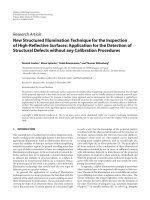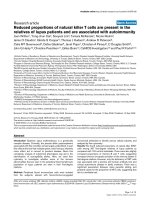New population-based exome data question the pathogenicity of some genetic variants previously associated with Marfan syndrome
Bạn đang xem bản rút gọn của tài liệu. Xem và tải ngay bản đầy đủ của tài liệu tại đây (367.5 KB, 8 trang )
Yang et al. BMC Genetics 2014, 15:74
/>
RESEARCH ARTICLE
Open Access
New population-based exome data question the
pathogenicity of some genetic variants previously
associated with Marfan syndrome
Ren-Qiang Yang1,2,3*, Javad Jabbari1,2, Xiao-Shu Cheng3, Reza Jabbari1,2, Jonas B Nielsen1,2, Bjarke Risgaard1,2,
Xu Chen1,2, Ahmad Sajadieh4, Stig Haunsø1,2,5, Jesper Hastrup Svendsen1,2,5, Morten S Olesen1,2,5
and Jacob Tfelt-Hansen1,2,5
Abstract
Background: Marfan syndrome (MFS) is a rare autosomal dominantly inherited connective tissue disorder with an
estimated prevalence of 1:5,000. More than 1000 variants have been previously reported to be associated with MFS.
However, the disease-causing effect of these variants may be questionable as many of the original studies used low
number of controls. To study whether there are possible false-positive variants associated with MFS, four in silico
prediction tools (SIFT, Polyphen-2, Grantham score, and conservation across species) were used to predict the
pathogenicity of these variant.
Results: Twenty-three out of 891 previously MFS-associated variants were identified in the ESP. These variants were
distributed on 100 heterozygote carriers in 6494 screened individuals. This corresponds to a genotype prevalence of
1:65 for MFS. Using a more conservative approach (cutoff value of >2 carriers in the EPS), 10 variants affected a total
of 82 individuals. This gives a genotype prevalence of 1:79 (82:6494) in the ESP. A significantly higher frequency
of MFS-associated variants not present in the ESP were predicted to be pathogenic with the agreement of ≥3
prediction tools, compared to the variants present in the ESP (p = 3.5 × 10−15).
Conclusions: This study showed a higher genotype prevalence of MFS than expected from the phenotype
prevalence in the general population. The high genotype prevalence suggests that these variants are not the
monogenic cause of MFS. Therefore, caution should be taken with regard to disease stratification based on these
previously reported MFS-associated variants.
Keywords: Marfan syndrome, Genetic testing, HGMD, The NHLBI GO exome sequencing project, Variant
Background
Marfan syndrome (MFS; OMIM 154700), first described
by Antoine Marfan in 1898, is an autosomal dominantly
inherited connective tissue disorder with a phenotype
that involves mainly the cardiovascular, ocular, and
skeletal systems. The prevalence of MFS in the general
US and European population has been estimated to be
1:5,000 [1,2]. MFS has a high penetrance, but variable
* Correspondence:
1
Laboratory of Molecular Cardiology, Department of Cardiology, the Heart
Centre, Copenhagen University Hospital, Rigshospitalet, Copenhagen,
Denmark
2
The Danish National Research Foundation Centre for Cardiac Arrhythmia,
Copenhagen, Denmark
Full list of author information is available at the end of the article
expression [3]. Cardiovascular complications are the main
cause of premature death among MFS patients [4,5].
Besides aortic aneurysm and/or dissection, MFS can lead
to valvular heart disease [6], enlargement of the proximal
pulmonary artery [7], congestive heart failure [8], and
arrhythmias [9].
According to the current “revised Ghent nosology”,
the diagnosis of MFS should be based on clinical manifestation, family history, and molecular genetic testing of
the fibrillin 1 gene (FBN1 gene) and the clinical criteria
employs a set of manifestations in many tissues [10].
Approximately 25% of all MFS patients do not have a
family history and hence, represents new cases due to de
© 2014 Yang et al.; licensee BioMed Central Ltd. This is an Open Access article distributed under the terms of the Creative
Commons Attribution License ( which permits unrestricted use, distribution, and
reproduction in any medium, provided the original work is properly credited. The Creative Commons Public Domain
Dedication waiver ( applies to the data made available in this article,
unless otherwise stated.
Yang et al. BMC Genetics 2014, 15:74
/>
novo mutations [3]. To date, more than 1000 variants
have been reported to be associated with MFS [11]. Recently, transforming growth factor beta (TGFB) has been
found to play a pivotal role in the progression of MFS
[12]. A disease that has many similarities with Marfan
syndrome, termed Loeys-Dietz syndrome, was identified
to be caused by variants in the transforming growth
factor-beta type II receptor (TGFBR2) [13]. An atypical
or incomplete MFS has also been described in some patients caused by genetic variants in transforming growth
factor-beta type I receptor (TGFBR1) and TGFBR2 [14].
However, to our knowledge, there are no systematic
studies focusing on separating genetic noise from diseasecausing variations by identifying variants previously associated with MFS in large-scale populations.
Until recently, there has only been little knowledge
regarding the distribution of genetic variations in general
population, especially with regard to low-frequency variants of MFS. This is potentially a problem, when rare
variants are associated with MFS because of the risk of
false-positive findings. The disease-causing role of some
of these variants is questionable as many of these studies
have used low number of controls. This problem has
now partly been solved with the release of exome data
from the NHLBI GO Exome Sequencing Project (ESP).
Large-scale surveys of human genetic variations provide
an important chance to identify causative variants, notable for an excess of rare genetic variants [15].
The aim of this study was to identify false positive variants previously associated with Marfan syndrome. This is
important since genetic testing today is used in order to
confirm MFS diagnose according to the revised Ghent
Nosology. In the absence of family history and aortic root
dilatation/dissection, but presence of ectopialentis, the
identification of an FBN1 variant previously associated
with aortic disease is required in making the diagnosis.
Also in the absence of family history and ectopialentis, but
presence of aortic root dilatation/dissection a genetic test
for identification of mutation in FBN1 is sufficient to
establish a MFS diagnosis. Due to the importance of a
positive genetic finding in patients suspected of MFS,
identification of false positive variants has major clinical
implications. Furthermore, we aimed to provide comprehensive in silico prediction analysis to all MFS-associated
variants, in order to better classify the impact of the variations on the encoded proteins.
Methods
In the ESP, next-generation sequencing was carried out
for all protein-coding regions in 6,503 individuals from
different population studies [16]. It currently contains
2,203 unrelated African-Americans (AA) and 4,300 unrelated European-Americans (EA) (13,006 alleles in
total). In the ESP database, samples were selected to
Page 2 of 8
contain healthy controls, the extremes of specific traits
(LDL and blood pressure), and specific diseases (early
onset myocardial infarction and early onset stroke), and
lung diseases. To our knowledge, patients with MFS
have not been included intentional in ESP. Clinical data
were not available, nor on request.
To find all genes and variants associated with MFS, a
search for missense and nonsense variants was performed in the Human Gene Mutation Database (HGMD
Professional 2013.2) [17]. Additionally, the following literature search query was used in the PubMed database
((Marfan) OR (Marfan syndrome) or (“Marfan syndrome”
[Mesh])) AND ((Genetic) OR (“Genetics” [Mesh])) AND
((mutation) OR (variant)). In this way, we included 3
variants recently associated with MFS [18-20]. Finally, we
searched the ESP for all these variants (Version: v.0.0.20.
(June 7, 2013)). We used a terminology so that MFSassociated variants identified in the ESP database are
termed ESP-Positive variants and variants not identified in
ESP as ESP-Negative variants. Because of lack of data������������������������������������������������������������������������������������������������������������������������������������������������������������������������������������������������������������������������������������������������������������������������������������������������������������������������������������������������������������������������������������������������������������������������������������������������������������������������������������������������������������������������������������������������������������������������������������������������������������������������������������������������������������������������������������������������������������������������������������������������������������������������������������������������������������������������������������������������������������������������������������������������������������������������������������������������������������������������������������������������������������������������������������������������������������������������������������������������������������������������������������������������������������������������������������������������������������������������������������������������������������������������������������������������������������������������������������������������������������������������������������������������������������������������������������������������������������������������������������������������������������������������������������������������������������������������������������������������������������������������������������������������������������������������������������������������������������������������������������������������������������������������������������������������������������������������������������������������������������������������������������������������������������������������������������������������������������������������������������������������������������������������������������������������������������������������������������������������������������������������������������������������������������������������������������������������������������������������������������������������������������������������������������������������������������������������������������������������������������������������������������������������������������������������������������������������������������������������������������������������������������������������������������������������������������������������������������������������������������������������������������������������������������������������������������������������������������������������������������������������������������������������������������������������������������������������������������������������������������������������������������������������������������������������������������������������������������������������������������������������������������������������������������������������������������������������������������������������������������������������������������������������������������������������������������������������������������������������������������������������������������������������������������������������������������������������������������������������������������������������������������������������������������������������������������������������������������������������������������������������������������������������������������������������������������������������������������������������������������������������������������������������������������������������������������������������������������������������������������������������������������������������������������������������������������������������������������������������������������������������������������������������������������������������������������������������������������������������������������������������������������������������������������������������������������������������������������������������������������������������������������������������������������������������������������������������������������������������������������������������������������������������������������������������������������������������������������������������������������������������������������������������������������������������������������������������������������������������������������������������������������������������������������������������������������������������������������������������������������������������������������������������������������������������������������������������������������������������������������������������������������������������������������������������������������������������������������������������������������������������������������������������������������������������������������������������������������������������������������������������������������������������������������������������������������������������������������������������������������������������������������������������������������������������������������������������������������������������������������������������������������������������������������������������������������������������������������������������������������������������������������������������������������������������������������������������������������������������������������������������������������������������������������������������������������������������������������������������������������������������������������������������������������������������������������������������������������������������������������������������������������������������������������������������������������������������������������������������������������������������������������������������������������������������������������������������������������������������������������������������������������������������������������������������������������������������������������������������������������������������������������������������������������������������������������������������������������������������������������������������������������������������������������������������������������������������������������������������������������������������������������������������������������������������������������������������������������������������������������������������������������������������������������������������������������������������������������������������������������������������������������������������������������������������������������������������������������������������������������������������������������������������������������������������������������������������������������������������������������������������������������������������������������������������������������������������������������������������������������������������������������������������������������������������������������������������������������������������������������������������������������������������������������������������������������������������������������������������������������������������������������������������������������������������������������������������������������������������������������������������������������������������������������������������������������������������������������������������������������������������������������������������������������������������������������������������������������������������������������������������������������������������������������������������������������������������������������������������������������������������������������������������������������������������������������������������������������������������������������������������������������������������������������������������������������������������������������������������������������������������������������������������������������������������������������������������������������������������������������������������������������������������������������������������������������������������������������������������������������������������������������������������������������������������������������������������������������������������������������������������������������������������������������������������������������������������������������������������������������������������������������������������������������������������������������������������������������������������������������������������������������������������������������������������������������������������������������������������������������������������������������������������������������������������������������������������������������������������������������������������������������������������������������������������������������������������������������������������������������������������������������������������������������������������������������������������������������������������������������������������������������������������������������������������������������������������������������������������������������������������������������������������������������������������������������������������������������������������������������������������������������������������������������������������������������������������������������������������������������������������������������������������������������������������������������������������������������������������������������������������������������������������������������������������������������������������������������������������������������������������������������������������������������������������������������������������������������������������������������������������������������������������������������������������������������������������������������������������������������������������������������������������������������������������������������������������������������������������������������������������������������������������������������������������������������������������������������������������������������������������������������������������������������������������������������������������������������������������������������������������������������������������������������������������������������������������������������������������������������������������������������������������������������������������������������������������������������������������������������������������������������������������������������������������������������������������������������������������������������������������������������������������������������������������������������������������������������������������������������������������������������������������������������������������������������������������������������������������������������������������������������������������������������������������������������������������������������������������������������������������������������������������������������������������������������������������������������������������������������������������������������������������������������������������������������������������������������������������������������������������������������������������������������������������������������������������������������������������������������������������������������������������������������������������������������������������������������������������������������������������������������������������������������������������������������������������������������������������������������������������������������������������������������������������������������������������������������������������������������������������������������������������������������������������������������������������������������������������������������������������������������������������������������������������������������������������������������������������������������������������������������������������������������������������������������������������������������������������������������������������������������������������������������������������������������������������������������������������������������������������������������������������������������������������������������������������������������������������������������������������������������������������������������������������������������������������������������������������������������������������������������������������������������������������������������������������������������������������������������������������������������������������������������������������
Tolerant
Benign
B (58)
NO
B
DM
NO
NO
AA = 0/AG = 14/GG = 6480 Damaging Probably damaging B (98)
c.3422C > T
NO
B
DM?
NO
NO
c.3509G > A rs137854475 TT = 0/TC = 25/CC = 6469
rs2228241
Tolerant
Benign
B (29)
YES
B
DM
YES
NO
c.3797A > T
Tolerant
Benign
B (22)
NO
B
DM
NO
NO
Damaging Benign
B (46)
YES
B
DM?
NO
NO
rs200283837 AA = 0/AT = 4/TT = 6490
c.3845A > G rs140647
CC = 0/CT = 3/TT = 6491
Damaging Probably damaging B (27)
NO
B
DM
NO
NO
FBN1 c.6055G > A rs377149130 TT = 0/TC = 1/CC = 6493
c.4270C > G rs201273753 CC = 0/CG = 4/GG = 6490
Tolerant
Possibly damaging
B (56)
NO
B
DM?
YES
NO
c.6700G > A rs112084407 TT = 0/TC = 8/CC = 6486
Tolerant
Benign
B (21)
NO
B
DM
NO
NO
c.7241G > A rs143863014 TT = 0/TC = 1/CC = 6493
Tolerant
Benign
B (43)
NO
B
DM
YES
NO
c.7379A > G rs144189837 CC = 0/CT = 2/TT = 6492
Tolerant
Possibly damaging
B (26)
c.7660C > T
Damaging Probably damaging D (101)
rs369294972 AA = 0/AG = 1/GG = 6493
c.7661G > A rs199522781 TT = 0/TC = 1/CC = 6493
Tolerant
c.7702G > A rs138558987 TT = 0/TC = 1/CC = 6493
Damaging Benign
B (21)
c.7846A > G rs143677764 CC = 0/CT = 4/TT = 6490
Tolerant
Benign
B (29)
c.7852G > A rs141133182 TT = 0/TC = 2/CC = 6492
Tolerant
Probably damaging D (125)
c.8081G > A rs371375126 TT = 0/TC = 1/CC = 6493
Tolerant
Benign
c.8176C > T
rs61746008
Probably damaging B (43)
AA = 0/AG = 14/GG = 6480 Damaging Benign
c.8494A > G rs376933421 CC = 0/CT = 1/TT = 6493
Tolerant
Benign
YES
B
DM
NO
NO
YES
D
DM
YES
NO
YES
B
DM?
NO
NO
YES
B
DM
NO
NO
NO
B
DM
YES
NO
YES
D
DM
NO
NO
B (43)
YES
B
DM
NO
NO
D (101)
NO
B
DM
YES
NO
B (56)
YES
B
DM
NO
NO
Yang et al. BMC Genetics 2014, 15:74
/>
Table 2 Functional data and family co-segregation for genes and variants in the ESP population
D: Damaging; B: Benign; DM: Disease causing mutation; ESP: Exome Sequencing Project; HGMD: Human Gene Mutation Database. EA: European Americans Genotype. AA: African Americans Genotype.
Page 5 of 8
Yang et al. BMC Genetics 2014, 15:74
/>
Page 6 of 8
Figure 1 Percentage of variants predicted to be pathogenic with four In silico tools prediction on variants present and not present in
ESP database. Differences in proportions of variants predicted to be damaging for those variants present in ESP versus variants not present in
ESP were assessed using Fisher’s exact test. *p = 4.1 × 10−10, **p = 2.8 × 10−11, ***p = 1.1 × 10−6, ****p = 4.5 × 10−5, *****p = 3.5 × 10−15.
not know the exact prevalence of MFS in the ESP population. So assuming that MFS is a monogenic disorder,
the findings of some variants with prevalence above the
cutoff value of more than 2 in the ESP suggest that some
of the variants at least may be false-positive, or incomplete penetrance. Reduced or incomplete penetrance is
not uncommon in genetic diseases. It can be resulted
from differential allelic expression or copy number variation [42]. The interpretation of variants with a prevalence below a certain cutoff value in the ESP may be
considered monogenic disease-causing, disease-modifier
or benign.
Genetic screening is gaining ground in the diagnostic
workup of families and identification of populations at a
high risk of suffering an inherited disease [43]. According to “the revised Ghent nosology”, genetic screening
for variants may in some cases be the game changer in
making the diagnose MFS [10].
Genetic screening for MFS in family members has
become an important tool in family cascade screening.
In particular, targeted testing of FBN1 is recommended
in cases where MFS is suspected following a cardiac
examination. It is noteworthy, that only 23 out of 861
(3%) variants in FBN1 were identified in the ESP. That
is, 97% of the variants in FBN1were not among nearly
6,500 subjects in the ESP. This confirms the pivotal role
and usefulness of the FBN1 gene in genetic screening.
Awareness of an FBN1 variant should imply for increased vigilance for MFS. Treatment with an angiotensin receptor blocker has been proven to be effective in
reducing rates of aortic root dilatation in MFS patients.
So knowledge of an FBN-1 variant may allow actionable
interventions earlier in the natural history of the condition [5].
Lack of properly scaled control populations has always
been a problem when dealing with low frequency genetic
variations of rare monogenetic diseases. Without a reasonable control population we might misdiagnose family
members undergoing genetic testing and follow-up.
Based on our study, we strongly suggest that exome
data, like the ESP, should be used as empirical data in
research and clinical practice, alongside with known prediction tools to get a more exact understanding of the
pathogenicity of the variants associated with MFS or
other rare inherited disorders. It is important to keep in
mind that the absence of variants in the ESP in itself, is
not to be interpreted as the variant is disease causing,
but certainly strengthen the possibility. Furthermore the
Marfan-related mutations analyses in this study do not
exclude that further potentially false-positive variants
could be found in healthy persons in other populations
such as Asians. Comparing findings in this study with
other populations may reduce the rate of false positive
variants.
Conclusion
In this study we have identified 23 previously reported
MFS-associated variants in the ESP database. The genotype prevalence of these variants corresponded to MFS
prevalence of 1:65. The high genotype prevalence questions the causality of some of these variants, suggesting
that these variants may not be the monogenic cause of
MFS. Therefore, caution should be taken with regard to
Yang et al. BMC Genetics 2014, 15:74
/>
Page 7 of 8
disease stratification based on variants previously associated with MFS.
Additional files
Additional file 1: The methods of prediction and genotyping a
variant in Northern European control population.
4.
Additional file 2: Table S1. Variants associated with Marfan syndrome
not present in ESP.
Additional file 3: Table S2. Clinical data of FBN-1 ESP-positive variants.
Additional file 4: Figure S1. Percentage of variants predicted to be
pathogenic with four In silico tools prediction on variants present and
not present in ESP database. Differences in proportions of variants
predicted to be damaging for those variants present in ESP versus
variants not present in ESP. Furthermore, variants with low frequency
(rare non-synonymous variants (<=2)) in the ESP is also shown.
Competing interests
The authors declare that they have no competing interest.
Authors’ contributions
RQY, JJ, XSC, RJ, JBN, BR, XC, AS, JHS, SH, MSO, and JT were involved in the
data collection and analysis, and design of the study. RQY, JJ, MSO, and JT
carried out the data analysis. JJ carried out statistical calculation. RQY, JJ, JBN,
BR, MSO, and JT drafted the manuscript. All authors reviewed the manuscript
and approved the final version.
5.
6.
7.
8.
9.
10.
Acknowledgements
The authors would like to thank the NHLBI GO Exome Sequencing Project
and its ongoing studies which produced and provided exome variant calls
for comparison: the Lung GO Sequencing Project (HL-102923), the WHI
Sequencing Project (HL-102924), the Broad GO Sequencing Project
(HL-102925), the Seattle GO Sequencing Project (HL-102926) and the
Heart GO Sequencing Project (HL-103010).
The work was supported by The Danish Heart Foundation, The Danish
National Research Foundation Centre for Cardiac Arrhythmia (DARC), The
John and Birthe Meyer Foundation, The Research Foundation at the Heart
Centre, Rigshospitalet. National Natural Science Foundation of China
[81160027], National Science and Technology Infrastructure Program of
China [2013BAI05B10].
Author details
1
Laboratory of Molecular Cardiology, Department of Cardiology, the Heart
Centre, Copenhagen University Hospital, Rigshospitalet, Copenhagen,
Denmark. 2The Danish National Research Foundation Centre for Cardiac
Arrhythmia, Copenhagen, Denmark. 3Department of Cardiology, Institute of
Cardiovascular Disease, the Heart Centre, the Second Affiliated Hospital,
Nanchang University, Nanchang, China. 4Department of Cardiology,
Copenhagen University Hospital of Bispebjerg, Bispebjerg, Denmark.
5
Department of Medicine and Surgery, Faculty of Health and Medical
Science, University of Copenhagen, Copenhagen, Denmark.
Received: 4 November 2013 Accepted: 2 June 2014
Published: 18 June 2014
References
1. Arbustini E, Grasso M, Ansaldi S, Malattia C, Pilotto A, Porcu E, Disabella E,
Marziliano N, Pisani A, Lanzarini L, Mannarino S, Larizza D, Mosconi M,
Antoniazzi E, Zoia MC, Meloni G, Magrassi L, Brega A, Bedeschi MF,
Torrente I, Mari F, Tavazzi L: Identification of sixty-two novel and twelve
known FBN1 mutations in eighty-one unrelated probands with Marfan
syndrome and other fibrillinopathies. Hum Mutat 2005, 26(5):1–15.
2. Judge DP, Dietz HC: Marfan’s syndrome. Lancet 2005, 366(9501):1965–1976.
3. Hiratzka LF, Bakris GL, Beckman JA, Bersin RM, Carr VF, Casey DE Jr, Eagle KA,
Hermann LK, Isselbacher EM, Kazerooni EA, Kouchoukos NT, Lytle BW,
Milewicz DM, Reich DL, Sen S, Shinn JA, Svensson LG, Williams DM: ACCF/
AHA/AATS/ACR/ASA/SCA/SCAI/SIR/STS/SVM Guidelines for the diagnosis
and management of patients with thoracic aortic disease: a report of
11.
12.
13.
14.
15.
16.
17.
18.
19.
20.
21.
22.
the American College of Cardiology Foundation/American Heart
Association Task Force on Practice Guidelines, American Association for
Thoracic Surgery, American College of Radiology, American Stroke
Association, Society of Cardiovascular Anesthesiologists, Society for
Cardiovascular Angiography and Interventions, Society of Interventional
Radiology, Society of Thoracic Surgeons, and Society for Vascular
Medicine. J Am Coll Cardiol 2010, 55(14):e27–e129.
Schoenhoff FS, Jungi S, Czerny M, Roost E, Reineke D, Matyas G, Steinmann
B, Schmidli J, Kadner A, Carrel T: Acute aortic dissection determines the
fate of initially untreated aortic segments in Marfan syndrome.
Circulation 2013, 127(15):1569–1575.
Barrett PM, Topol EJ: The fibrillin-1 gene: unlocking new therapeutic
pathways in cardiovascular disease. Heart 2013, 99(2):83–90.
Lacro RV, Guey LT, Dietz HC, Pearson GD, Yetman AT, Gelb BD, Loeys BL,
Benson DW, Bradley TJ, De Backer J, Forbus GA, Klein GL, Lai WW,
Levine JC, Lewin MB, Markham LW, Paridon SM, Pierpont ME, Radojewski E,
Selamet Tierney ES, Sharkey AM, Wechsler SB, Mahony L: Pediatric
Heart Network Investigators: characteristics of children and young
adults with Marfan syndrome and aortic root dilation in a randomized
trial comparing atenolol and losartan therapy. Am Heart J 2013,
165(5):828–835.
Pati PK, George PV, Jose JV: Giant pulmonary artery aneurysm with
dissection in a case of Marfan syndrome. J Am Coll Cardiol 2013,
61(6):685.
De Backer JF, Devos D, Segers P, Matthys D, Franỗois K, Gillebert TC, De
Paepe AM, De Sutter J: Primary impairment of left ventricular function in
Marfan syndrome. Int J Cardiol 2006, 112(3):353–358.
Halushka MK: Single gene disorders of the aortic wall. Cardiovasc Pathol
2012, 21(4):240–244.
Loeys BL, Dietz HC, Braverman AC, Callewaert BL, De Backer J, Devereux RB,
Hilhorst-Hofstee Y, Jondeau G, Faivre L, Milewicz DM, Pyeritz RE, Sponseller
PD, Wordsworth P, De Paepe AM: The revised Ghent nosology for the
Marfan syndrome. J Med Genet 2010, 47(7):476–485.
Gillis E, Van Laer L, Loeys BL: Genetics of thoracic aortic aneurysm: at the
crossroad of transforming growth factor-β signaling and vascular
smooth muscle cell contractility. Circ Res 2013, 113(3):327–340.
Sawaki D, Suzuki T: Targeting transforming growth factor-β signaling in
Aortopathies in Marfan syndrome. Circ J 2013, 77(4):898–899.
Stheneur C, Collod-Béroud G, Faivre L, Gouya L, Sultan G, Le Parc J-M,
Moura B, Attias D, Muti C, Sznajder M, Claustres M, Junien C, Baumann C,
Cormier-Daire V, Rio M, Lyonnet S, Plauchu H, Lacombe D, Chevallier B,
Jondeau G, Boileau C: Identification of 23 TGFBR2 and 6 TGFBR1 gene
mutations and genotype-phenotype investigations in 457 patients
with Marfan syndrome type I and II, Loeys-Dietz syndrome and related
disorders. Hum Mutat 2008, 29(11):E284–E295.
Singh KK, Rommel K, Mishra A, Karck M, Haverich A, Schmidtke J,
Arslan-Kirchner M: TGFBR1 and TGFBR2 mutations in patients with
features of Marfan syndrome and Loeys-Dietz syndrome. Hum Mutat
2006, 27(8):770–777.
Fu W, O’Connor TD, Jun G, Kang HM, Abecasis G, Leal SM, Gabriel S,
Altshuler D, Shendure J, Nickerson DA, Bamshad MJ, Akey JM: Analysis of
6,515 exomes reveals the recent origin of most human protein-coding
variants. Nature 2013, 493(7431):216–220.
Exome Variant Server. Retrieved from: />Biological Databases for Gene Expression, Pathway & NGS Analysis. Retrieved
from: />Dong J, Bu J, Du W, Li Y, Jia Y, Li J, Meng X, Yuan M, Peng X, Zhou A, Wang
L: A new novel mutation in FBN1 causes autosomal dominant Marfan
syndrome in a Chinese family. Mol Vis 2012, 18:81–86.
Van Den Bossche MJA, Van Wallendael KLP, Strazisar M, Sabbe B, Del-Favero
J: Co-occurrence of Marfan syndrome and schizophrenia: what can be
learned? Eur J Med Genet 2012, 55(4):252–255.
Hogue J, Lee C, Jelin A, Strecker M, Cox V, Slavotinek A: Homozygosity for
a FBN1 missense mutation causes a severe Marfan syndrome
phenotype. Clin Genet 2013, 84(4):392–393.
Giudicessi JR, Kapplinger JD, Tester DJ, Alders M, Salisbury BA, Wilde AAM,
Ackerman MJ: Phylogenetic and physicochemical analyses enhance the
classification of rare nonsynonymous single nucleotide variants in type 1
and 2 long-QT syndrome. Circ Cardiovasc Genet 2012, 5(5):519–528.
Tjeldhorn L, Rand-Hendriksen S, Gervin K, Brandal K, Inderhaug E, Geiran O,
Paus B: Rapid and efficient FBN1 mutation detection using automated
Yang et al. BMC Genetics 2014, 15:74
/>
23.
24.
25.
26.
27.
28.
29.
30.
31.
32.
33.
34.
35.
36.
37.
38.
sample preparation and direct sequencing as the primary strategy.
Genet Test 2006, 10(4):258–264.
Rommel K, Karck M, Haverich A, Schmidtke J, Arslan-Kirchner M: Mutation
screening of the fibrillin-1 (FBN1) gene in 76 unrelated patients with
Marfan syndrome or Marfanoid features leads to the identification
of 11 novel and three previously reported mutations. Hum Mutat 2002,
20(5):406–407.
Hung C-C, Lin S-Y, Lee C-N, Cheng H-Y, Lin S-P, Chen M-R, Chen C-P,
Chang C-H, Lin C-Y, Yu C-C, Chiu H-H, Cheng W-F, Ho H-N, Niu D-M, Su Y-N:
Mutation spectrum of the fibrillin-1 (FBN1) gene in Taiwanese patients
with Marfan syndrome. Ann Hum Genet 2009, 73(Pt 6):559–567.
Comeglio P, Johnson P, Arno G, Brice G, Evans A, Aragon-Martin J,
da Silva FP, Kiotsekoglou A, Child A: The importance of mutation detection
in Marfan syndrome and Marfan-related disorders: report of 193 FBN1
mutations. Hum Mutat 2007, 28(9):928.
Tiecke F, Katzke S, Booms P, Robinson PN, Neumann L, Godfrey M,
Mathews KR, Scheuner M, Hinkel GK, Brenner RE, Hövels-Gürich HH,
Hagemeier C, Fuchs J, Skovby F, Rosenberg T: Classic, atypically severe and
neonatal Marfan syndrome: twelve mutations and genotype-phenotype
correlations in FBN1 exons 24–40. Eur J Hum Genet 2001, 9(1):13–21.
Yuan B, Thomas JP, von Kodolitsch Y, Pyeritz RE: Comparison of
heteroduplex analysis, direct sequencing, and enzyme mismatch
cleavage for detecting mutations in a large gene, FBN1. Hum Mutat 1999,
14(5):440–446.
Hayward C, Porteous ME, Brock DJ: A novel mutation in the fibrillin gene
(FBN1) in familial arachnodactyly. Mol Cell Probes 1994, 8(4):325–327.
Mátyás G, De Paepe A, Halliday D, Boileau C, Pals G, Steinmann B:
Evaluation and application of denaturing HPLC for mutation detection in
Marfan syndrome: Identification of 20 novel mutations and two novel
polymorphisms in the FBN1 gene. Hum Mutat 2002, 19(4):443–456.
Liu WO, Oefner PJ, Qian C, Odom RS, Francke U: Denaturing HPLC-identified
novel FBN1 mutations, polymorphisms, and sequence variants in Marfan
syndrome and related connective tissue disorders. Genet Test 1997,
1(4):237–242.
Collod-Béroud G, Béroud C, Ades L, Black C, Boxer M, Brock DJ, Holman KJ,
de Paepe A, Francke U, Grau U, Hayward C, Klein HG, Liu W, Nuytinck L,
Peltonen L, Alvarez Perez AB, Rantamäki T, Junien C, Boileau C: Marfan
Database (third edition): new mutations and new routines for the
software. Nucleic Acids Res 1998, 26(1):229–223.
Sheikhzadeh S, Kade C, Keyser B, Stuhrmann M, Arslan-Kirchner M,
Rybczynski M, Bernhardt AM, Habermann CR, Hillebrand M, Mir T,
Robinson PN, Berger J, Detter C, Blankenberg S, Schmidtke J, von Kodolitsch
Y: Analysis of phenotype and genotype information for the diagnosis of
Marfan syndrome. Clin Genet 2012, 82(3):240–247.
Sakai H, Visser R, Ikegawa S, Ito E, Numabe H, Watanabe Y, Mikami H,
Kondoh T, Kitoh H, Sugiyama R, Okamoto N, Ogata T, Fodde R, Mizuno S,
Takamura K, Egashira M, Sasaki N, Watanabe S, Nishimaki S, Takada F, Nagai
T, Okada Y, Aoka Y, Yasuda K, Iwasa M, Kogaki S, Harada N, Mizuguchi T,
Matsumoto N: Comprehensive genetic analysis of relevant four genes in
49 patients with Marfan syndrome or Marfan-related phenotypes.
Am J Med Genet A 2006, 140(16):1719–1725.
Howarth R, Yearwood C, Harvey JF: Application of dHPLC for mutation
detection of the fibrillin-1 gene for the diagnosis of Marfan syndrome in
a National Health Service Laboratory. Genet Test 2007, 11(2):146–152.
Milewicz DM, Grossfield J, Cao SN, Kielty C, Covitz W, Jewett T: A mutation
in FBN1 disrupts profibrillin processing and results in isolated skeletal
features of the Marfan syndrome. J Clin Invest 1995, 95(5):2373–2378.
Mátyás G, Arnold E, Carrel T, Baumgartner D, Boileau C, Berger W,
Steinmann B: Identification and in silico analyses of novel TGFBR1 and
TGFBR2 mutations in Marfan syndrome-related disorders. Hum Mutat
2006, 27(8):760–769.
Refsgaard L, Holst AG, Sadjadieh G, Haunsø S, Nielsen JB, Olesen MS: High
prevalence of genetic variants previously associated with LQT syndrome
in new exome data. Eur J Hum Genet 2012, 20(8):905–908.
Risgaard B, Jabbari R, Refsgaard L, Holst A, Haunsø S, Sadjadieh A, Winkel B,
Olesen M, Tfelt-Hansen J: High prevalence of genetic variants previously
associated with Brugada syndrome in new exome data. Clin Genet 2013,
84(5):489–495.
Page 8 of 8
39. Andreasen C, Nielsen JB, Refsgaard L, Holst AG, Christensen AH,
Andreasen L, Sajadieh A, Haunsø S, Svendsen JH, Olesen MS: New
population-based exome data are questioning the pathogenicity of
previously cardiomyopathy-associated genetic variants. Eur J Hum Genet
2013, 21(9):918–928.
40. Lucarini L, Evangelisti L, Attanasio M, Lapini I, Chiarini F, Porciani MC,
Abbate R, Gensini G, Pepe G: May TGFBR1 act also as low penetrance
allele in Marfan syndrome? Int J Cardiol 2009, 131(2):281–284.
41. Jabbari J, Jabbari R, Nielsen MW, Holst AG, Nielsen JB, Haunsø S,
Tfelt-Hansen J, Svendsen JH, Olesen MS: New exome data question
the pathogenicity of genetic variants previously associated with
catecholaminergic polymorphic ventricular tachycardia. Circ Cardiovasc Genet
2013, 6(5):481–489.
42. Cooper DN, Krawczak M, Polychronakos C, Tyler-Smith C,
Kehrer-Sawatzki H: Where genotype is not predictive of phenotype:
towards an understanding of the molecular basis of reduced
penetrance in human inherited disease. Hum Genet 2013,
132(10):1077–1130.
43. Katsanis SH, Katsanis N: Molecular genetic testing and the future of
clinical genomics. Nat Rev Genet 2013, 14(6):415–426.
doi:10.1186/1471-2156-15-74
Cite this article as: Yang et al.: New population-based exome data
question the pathogenicity of some genetic variants previously associated
with Marfan syndrome. BMC Genetics 2014 15:74.
Submit your next manuscript to BioMed Central
and take full advantage of:
• Convenient online submission
• Thorough peer review
• No space constraints or color figure charges
• Immediate publication on acceptance
• Inclusion in PubMed, CAS, Scopus and Google Scholar
• Research which is freely available for redistribution
Submit your manuscript at
www.biomedcentral.com/submit


